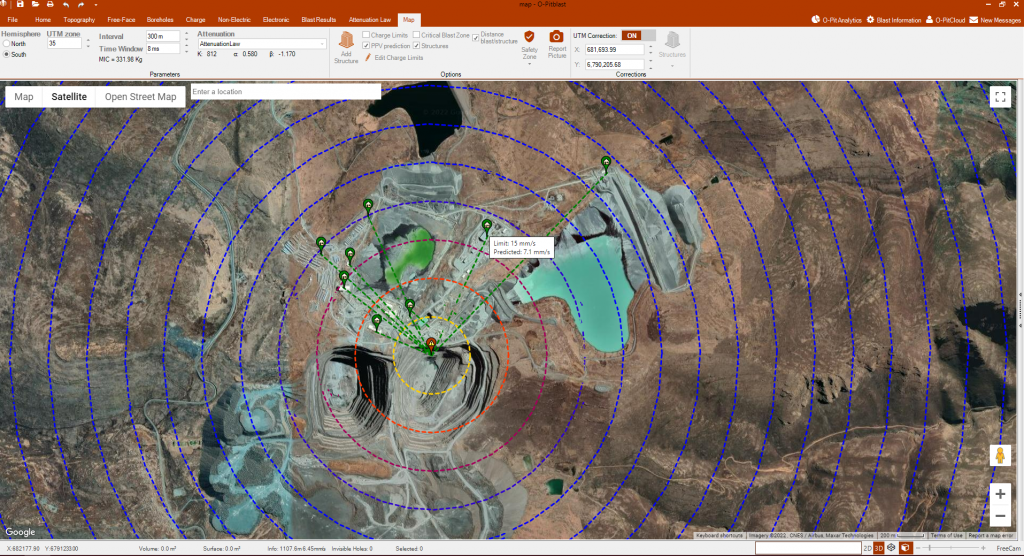
In surface mining, in order to fragment rocks and extract raw materials and minerals (e.g., ore, coal, copper, diamond, etc), the drilling-blasting method is a crucial method used. Even civil works, buildings, and roads are dependent on explosives and rock blasting. Nevertheless, any rock blasting, in certain circumstances can lead to unfavorable damages such as ground vibrations, overpressure, air blast, fly rocks, dust, and noxious gases due to the remaining energy that is wasted (Bhandari, 1997; Nguyen et al, 2021).
The vibration phenomena associated with rock blasting is one of the main engineer’s concerns when performing blasting activities because, if not properly controlled, can cause damage to nearby or surrounding structures or lead to natural or even human losses. From a mechanical point of view, a vibration is considered as an oscillatory movement of a particle around its stable position, produced by an impulse. This movement can be extremely complex due to several reasons, such as the existence of structures such as faults, fractures, and/or joints, layers of different types of rocks (as Figure 1 shows rock type A and rock type B), and/or blasting with boreholes that have different delays with a specific interval. The overlap of these tensile waves formed from different holes is one consequence result of the complexity of factors that can affect the propagation of explosion-generated waves (Couceiro, 2013).

Dowding, in 1985, refers to the fact that these waves can be transmitted:
- On the interior of the terrain mass is classified as waves with the capability to propagate within the body of solid material:
- P waves – also known as compressional/compressive waves due to their compressive behavior;
- S waves – also known as shear waves are characterized by distortional behavior.
2. At the surface of the terrain, outside of the body of solid material:
- R waves – also known as Rayleigh waves, are transmitted at long distances from the blast, moving the terrain in an elliptical vertical plane.

Attenuation Law Several variables (controllable and non-controllable) affect the vibration level resulting from a blast. Some of the main influences are (Jimeno et al., 1995; Bhandari, 1997):
- Geometric variables such as drill diameter, bench high, burden, spacing, sub-drill, stemming, holes inclination, decoupling ration, and blast size;
- Maximum instantaneous charge (MIC);
- Type and amount of explosive;
- Powder factor;
- Delay times;
- Geology and rock characteristics;
- Blast direction; and
- Distance to structures;
To control ground vibrations, many researchers have suggested empirical approaches for prediction based on the datasets collected by blasting seismographs (like GSS sensors and SWARM vibration monitor). The use of these methods relates PPVs (Peak Particle Velocity) with distances and charges, to predetermine the blast charge limits to minimize vibration effects (since Morris – 1950 up to Dowding – 1985). The PPV is generally given as mm/sec (millimeters per second), or in/sec (inches per second) and it is the most acknowledged and utilized indicator of ground vibration levels. For each recorded waveform, the maximum particle velocity (over the total recorded time) that a particle moves, while a vibration wave is passed through it, is regarded as the PPV (Alcudia et al., 2007; Figure 3).

As referred by Dowding (1985), the passage of blasting vibrations forces the ground particles to move in an elliptical manner in three dimensions. Thus, to define the movement, as shown in Figure 4, three mutually perpendicular components are measured. Consequently, the PPV can be the peak of a single channel of a triax (transverse; radial or longitudinal; or vertical) or the peak vector sum (PVS – which reflects the effect of all components). The highest value of these three components is the maximum peak particle velocity, which will primarily be controlled by the amount of energy released and the distance from the blast.

The first meaningful equation that allowed the calculation of PPV was proposed by the Department of Mining Engineering in the United States (USBM – United States Bureau of Mines)(Hosseini & Baghikhani, 2013). There are also modified predictors from other researchers or institutions such as Langefors and Kihlstrom, Ambraseys and Hendrn, Bureau of Indian, Ghosh, andDaemen (Ragam and Nimaje, 2018).
In fact, the prediction of vibration phenomena is a very powerful procedure allowing the mining or blasting engineer to control, predict and mitigate safety and environmental issues before a blast, performing the necessary actions (Miranda, Leite, Jesus, & Sobral, 2017). Thus, nowadays, it is inconceivable to work on large engineering projects without carrying out to characterize blast vibration effects in a heterogenic terrain, anisotropic behaviors, and subsequent control of the levels of vibrations obtained from detonations (Couceiro, 2013). For this reason, an Attenuation Law – prediction model as can be consulted in video 1 – is established as the best process to estimate and describe the behavior of wave movement, using experimental (or existent) vibration data to build it. However, it is advisable to take into consideration that the formulation of a general attenuation law is subject to estimation errors strongly related to uncontrollable constraints.
Video1–The video comprises the import of PPV dataset(longitudinal, vertical, and transverse components)–using a blast seismography device – in O-Pitblast Software in order to obtain a vibration prediction model: Attenuation Law.
Regarding the different approaches that were done as mentioned above related to the PPV calculations, the expression that is the most used and acquainted in terms of Attenuation Laws studies, and the current use in O-Pitblast Software is determined by:

In this way, we can clarify the idea about vibration prediction using Attenuation Law and how important is to monitor near communities, civil structures, or any near urban area of blasting projects to guarantee safety. It is important to enhance that each country has its own permissible national standards for maximum vibration limits.
See you all soon





